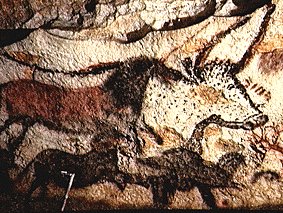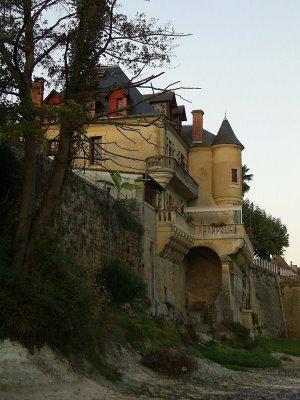
|
|
|
|
|
Home » Archives for October 2005
Monday, October 31
Fishing in France
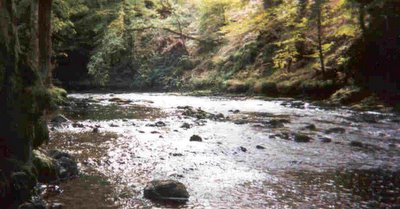
 France is a fisherman's paradise. Not only are the carp amazing and the coarse fishing therefor of the best, but many other kinds of fish are to be found in abundance in the many lakes and rivers.
France is a fisherman's paradise. Not only are the carp amazing and the coarse fishing therefor of the best, but many other kinds of fish are to be found in abundance in the many lakes and rivers. Trout and fly fishing provide enough challenges even for the master at the sport. The brown trout especially are wild and "mean", very dark with red dots. River beds of peat and granite produce fish more "nervous" than "fat". Miles of public stretches are available. There are good but unpredictable early season hatches, but the best period would start by early June.
The river is sometimes friendly, sometimes tough and sometimes hides holes. Wading pants with felt soles are required. Fishing from the banks is possible but wading gives access to more places.
Landscape of woody hills and cattle meadows. At the end of summer are found the first wild mushrooms "cèpes" or "trompettes des morts", morels are found also in April.
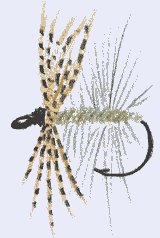 The "Assassine" is a variant of the "Mouches Exquises" (exquisite flies) of the legendary Docteur Juge. Two turns of partridge in front of a grey coq du Limousin palmered hackle.
The "Assassine" is a variant of the "Mouches Exquises" (exquisite flies) of the legendary Docteur Juge. Two turns of partridge in front of a grey coq du Limousin palmered hackle. The main river is the Vézère as per picture above, but there are other rivers you can fly fish around if you want to visit more. These were the lands and rivers of the Famous Docteur Juge, notorious fly fisherman and hunter, fly patterns inventor and author of a few appreciated fly fishing books in the 40's and 50's.
TAGS: Fishing France
chateau
Posted by
Unknown
.....and --- Five reasons to visit Paris............
.........As if you need any!.....
Paris has changed quite a bit in the thirty years since I lived there. Apart from graffiti and litter and other debris blown in from North Africa, I have to agree with Kimberly Kradel when she says "it has become more of a global city, influenced not only by current events, but by the different cultures that have come to live within her periphique. If you have any kind of desire to go to Paris, just get on a plane right now and go! But if you are hedging between visiting Paris and any other city on the planet, here are my reasons to make the City of Light your top pick.
Un: Energy. Inspiration. Innovation. Abandon. Le vivre. The pursuit of enlightenment, French style. Not things to be seen, but rather a feeling that swims in the air. Paris is one of those places that just grabs you, hugs you, and gives you long slow kisses, sensually, without being too obvious about it, all before you even realize it. The French people on the other hand are a little more reserved, but they warm up. Nothing that a few words of practiced French won't cure. Paris also has the nerve to make you think. She will inspire you and teach you, even if you aren't expecting it. But if you are an artist at a loss for your next project, there's nothing like a trip to Paris to get the inspirational wheels turning again.
Deux: Gastronomie! The food and drink in Paris really are fabulous. Whether you are eating sandwiches and quiches out of the boulangeries everyday or splurging on restaurants, a taste of France is not to be missed. Eating a true Parisian baguette with a slice of generic French brie alone is worth the airfare, let alone all the other wonders of the French palette - from crêpes to bouillabaisse. The lovely way that chicken tastes like eggs and eggs taste remarkably fresh is divine and not to be missed. Cheeses to be experienced that faintly hint of the grasses that the sheep and cows eat in the field. Freshly pressed olive oils that enliven a plate of greens. You may no longer be able to find that inexpensive wine on the shelf, but the French reds are some of the best you will taste. And don't forget the champagne!
Paris is truly a melting pot not only of French gastronomic culture, blending all of the cuisines of the provinces of France in one city, but also of world cuisine, and the recipes of her many multi-cultural inhabitants.
Trois: You wouldn't be reading this if you weren't at least a little bit interested in art, architecture and artists. Paris has an excellent collection of all three. The city itself is a walking history museum and even if you didn't step foot in a building, you couldn't help but be inspired by what is out on the streets.
There are wonderful museums like the beautiful d'Orsay displaying floors of Impressionist work, the labrynthine maze of Le Louvre where Winged Victory and Michelangelo's Slaves live, the mind-boggling Pompideau with its displays of contempory art and culture, the unicorn tapestries of the Cluny and the art of Picasso at the museum named after him.
The galleries of Rue du Seine in the 6th arrondisement and the Marais hold everything from antique lawn sculptures to the work of world class artists.
The artists' ateliers are open during Les Portes Ouvertes which happen at various times of the year, primarily in the neighborhoods of Belleville and Oberkampf but also in the Bastille.
The architecture of the first gothic cathedral in Europe, Saint-Denis, with its tombs of Kings and Royal Families, as well as the gargoyles of Notre-Dame, the mysteries of Saint-Sulpice and many of the other cathedrals in the city are preserved in their original forms. The term gothic tends to bring dark, somber, stormy night, visuals to mind, but gothic is really all about light and the opening up of space to let the light of God shine in or the rays of enlightenment bathe you into perfection - this particular style of architechture is all about contemplation.
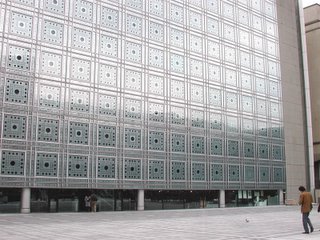 The windows of L'Insitute du Monde Arabe also bring new light onto the subjects of Islam and Arab culture. One of the good things Mitterand initiated, this spectacular building is a must-see -- if only for its stunning architecture.The window shades are controlled by solar power and open and close according to how much direct sunlight they are getting, maintaining the light level inside to the same level throughout the day. The shades themselves create geometric patterns that form as the shades open and close.
The windows of L'Insitute du Monde Arabe also bring new light onto the subjects of Islam and Arab culture. One of the good things Mitterand initiated, this spectacular building is a must-see -- if only for its stunning architecture.The window shades are controlled by solar power and open and close according to how much direct sunlight they are getting, maintaining the light level inside to the same level throughout the day. The shades themselves create geometric patterns that form as the shades open and close. 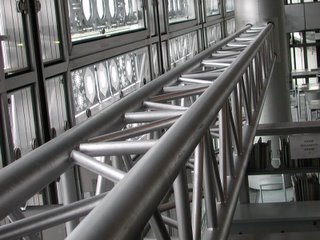
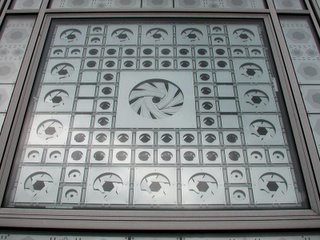
And coming back to graffiti! ---- Graffiti has truly become an art form in Paris and good, artistic graffiti and wall murals, although not in the least encouraged in their making, are an accepted from of expression in some neighborhoods.
The flea markets, shops, and whole neighborhoods hold antiques and wonders to pilfer through to find that one thing that will serve as a souvenir of your visit.
You will find no other city with a list of art and creative venues like Paris. The city is a living museum, with remnants from Lutetia Parisorium to La Revolution, to whatever happened in history yesterday discussed in your local cafe.
Quatre: From Paris there is a wonderful selection of daytrips outside the city - from Giverny to Auvers, Auvers to Fountainbleau, Fountainbleau to Versailles and back again. See the residence of Monet, the grave of Van Gogh, the country residences and gardens of Napolean and Louis XVI. And what about taking the train an hour out of town to Chartres, Beauvais, Amiens or Reims to see the cathedrals, a hike in the forest of Chantilly, or off to Epernay to taste a bit of champagne?
Cinq: Passing time in a cafe and people watching. What could be more Parisian than this? The neighborhood cafes are the living rooms and meeting places of the Parisians. Cafes are where they make new friends and keep old friendships alive. It's where the neighborhood gossip gets stirred. And for a traveler, whether you are interested in watching the latest fashion walk by, sipping a Pernod, a bierre, a glass of red wine, savoring a cafe au lait, reading le quotidien, or just relaxing and resting your weary feet on la terasse, cafe life in Paris is life at its best.
--------------------------------------------------------------------------------
From French to English
periphique = periphial. Paris does not have a city wall surrounding her boundry, but she does have a freeway that completey encircles the city.
Le vivre = the life
gastronomie = gastronomy
boulangeries = bakeries where you can find the ubiquitous baguettes and other French breads, as well as croissants, tartes, quiches and sandwiches for lunch. Not to be confused with:
patisseries = that are also bakeries, but ones that offer more sweet items like chocolates and fancy cakes.
crêpes = crepes, a very thin pancake that can be 'sweet' and stuffed with fruits, chocolate, or a filling like lemon curd or nutella, or:
gallettes: the 'savory' version of crepes, and stuffed with just about anything, from eggs to ham, from potatoes to tomatoes, to cheese.
bouillabaisse = a traditional fish and seafood stew.
Les Portes Ouvertes = Open Studios, literally Open Doors. A highly organized event by aritists in a neighborhood, when they all open their doors on the same day and people go around from studio to studio to meet them and look at their work.
L'Insitute du Monde Arabe = The Institute of the Arab World, a great cultural center in the heart of Paris.
Lutetia Parisorium = The original name of the settlement of Paris, located where Notre-Dame now sits.
La Revolution = The Revolution, in this case The French Revolution of 1789 - 1799
un grand creme = coffee with milk
la terasse = on the terrace, to sit outside of the cafe at a table on the street.
le quotidien = 'the daily' newspaper
un, deux, trois, quatre, cinq! = one, two, three, four, five!
Bon Voyage! = Have a Great Trip!
Paris has changed quite a bit in the thirty years since I lived there. Apart from graffiti and litter and other debris blown in from North Africa, I have to agree with Kimberly Kradel when she says "it has become more of a global city, influenced not only by current events, but by the different cultures that have come to live within her periphique. If you have any kind of desire to go to Paris, just get on a plane right now and go! But if you are hedging between visiting Paris and any other city on the planet, here are my reasons to make the City of Light your top pick.
Un: Energy. Inspiration. Innovation. Abandon. Le vivre. The pursuit of enlightenment, French style. Not things to be seen, but rather a feeling that swims in the air. Paris is one of those places that just grabs you, hugs you, and gives you long slow kisses, sensually, without being too obvious about it, all before you even realize it. The French people on the other hand are a little more reserved, but they warm up. Nothing that a few words of practiced French won't cure. Paris also has the nerve to make you think. She will inspire you and teach you, even if you aren't expecting it. But if you are an artist at a loss for your next project, there's nothing like a trip to Paris to get the inspirational wheels turning again.
Deux: Gastronomie! The food and drink in Paris really are fabulous. Whether you are eating sandwiches and quiches out of the boulangeries everyday or splurging on restaurants, a taste of France is not to be missed. Eating a true Parisian baguette with a slice of generic French brie alone is worth the airfare, let alone all the other wonders of the French palette - from crêpes to bouillabaisse. The lovely way that chicken tastes like eggs and eggs taste remarkably fresh is divine and not to be missed. Cheeses to be experienced that faintly hint of the grasses that the sheep and cows eat in the field. Freshly pressed olive oils that enliven a plate of greens. You may no longer be able to find that inexpensive wine on the shelf, but the French reds are some of the best you will taste. And don't forget the champagne!
Paris is truly a melting pot not only of French gastronomic culture, blending all of the cuisines of the provinces of France in one city, but also of world cuisine, and the recipes of her many multi-cultural inhabitants.
Trois: You wouldn't be reading this if you weren't at least a little bit interested in art, architecture and artists. Paris has an excellent collection of all three. The city itself is a walking history museum and even if you didn't step foot in a building, you couldn't help but be inspired by what is out on the streets.
There are wonderful museums like the beautiful d'Orsay displaying floors of Impressionist work, the labrynthine maze of Le Louvre where Winged Victory and Michelangelo's Slaves live, the mind-boggling Pompideau with its displays of contempory art and culture, the unicorn tapestries of the Cluny and the art of Picasso at the museum named after him.
The galleries of Rue du Seine in the 6th arrondisement and the Marais hold everything from antique lawn sculptures to the work of world class artists.
The artists' ateliers are open during Les Portes Ouvertes which happen at various times of the year, primarily in the neighborhoods of Belleville and Oberkampf but also in the Bastille.
The architecture of the first gothic cathedral in Europe, Saint-Denis, with its tombs of Kings and Royal Families, as well as the gargoyles of Notre-Dame, the mysteries of Saint-Sulpice and many of the other cathedrals in the city are preserved in their original forms. The term gothic tends to bring dark, somber, stormy night, visuals to mind, but gothic is really all about light and the opening up of space to let the light of God shine in or the rays of enlightenment bathe you into perfection - this particular style of architechture is all about contemplation.
 The windows of L'Insitute du Monde Arabe also bring new light onto the subjects of Islam and Arab culture. One of the good things Mitterand initiated, this spectacular building is a must-see -- if only for its stunning architecture.The window shades are controlled by solar power and open and close according to how much direct sunlight they are getting, maintaining the light level inside to the same level throughout the day. The shades themselves create geometric patterns that form as the shades open and close.
The windows of L'Insitute du Monde Arabe also bring new light onto the subjects of Islam and Arab culture. One of the good things Mitterand initiated, this spectacular building is a must-see -- if only for its stunning architecture.The window shades are controlled by solar power and open and close according to how much direct sunlight they are getting, maintaining the light level inside to the same level throughout the day. The shades themselves create geometric patterns that form as the shades open and close. 

And coming back to graffiti! ---- Graffiti has truly become an art form in Paris and good, artistic graffiti and wall murals, although not in the least encouraged in their making, are an accepted from of expression in some neighborhoods.
The flea markets, shops, and whole neighborhoods hold antiques and wonders to pilfer through to find that one thing that will serve as a souvenir of your visit.
You will find no other city with a list of art and creative venues like Paris. The city is a living museum, with remnants from Lutetia Parisorium to La Revolution, to whatever happened in history yesterday discussed in your local cafe.
Quatre: From Paris there is a wonderful selection of daytrips outside the city - from Giverny to Auvers, Auvers to Fountainbleau, Fountainbleau to Versailles and back again. See the residence of Monet, the grave of Van Gogh, the country residences and gardens of Napolean and Louis XVI. And what about taking the train an hour out of town to Chartres, Beauvais, Amiens or Reims to see the cathedrals, a hike in the forest of Chantilly, or off to Epernay to taste a bit of champagne?
Cinq: Passing time in a cafe and people watching. What could be more Parisian than this? The neighborhood cafes are the living rooms and meeting places of the Parisians. Cafes are where they make new friends and keep old friendships alive. It's where the neighborhood gossip gets stirred. And for a traveler, whether you are interested in watching the latest fashion walk by, sipping a Pernod, a bierre, a glass of red wine, savoring a cafe au lait, reading le quotidien, or just relaxing and resting your weary feet on la terasse, cafe life in Paris is life at its best.
--------------------------------------------------------------------------------
From French to English
periphique = periphial. Paris does not have a city wall surrounding her boundry, but she does have a freeway that completey encircles the city.
Le vivre = the life
gastronomie = gastronomy
boulangeries = bakeries where you can find the ubiquitous baguettes and other French breads, as well as croissants, tartes, quiches and sandwiches for lunch. Not to be confused with:
patisseries = that are also bakeries, but ones that offer more sweet items like chocolates and fancy cakes.
crêpes = crepes, a very thin pancake that can be 'sweet' and stuffed with fruits, chocolate, or a filling like lemon curd or nutella, or:
gallettes: the 'savory' version of crepes, and stuffed with just about anything, from eggs to ham, from potatoes to tomatoes, to cheese.
bouillabaisse = a traditional fish and seafood stew.
Les Portes Ouvertes = Open Studios, literally Open Doors. A highly organized event by aritists in a neighborhood, when they all open their doors on the same day and people go around from studio to studio to meet them and look at their work.
L'Insitute du Monde Arabe = The Institute of the Arab World, a great cultural center in the heart of Paris.
Lutetia Parisorium = The original name of the settlement of Paris, located where Notre-Dame now sits.
La Revolution = The Revolution, in this case The French Revolution of 1789 - 1799
un grand creme = coffee with milk
la terasse = on the terrace, to sit outside of the cafe at a table on the street.
le quotidien = 'the daily' newspaper
un, deux, trois, quatre, cinq! = one, two, three, four, five!
Posted by
Unknown
Saturday, October 29
Quirky Quoi Qu'il Soit
Saturday morning at Sarlat market.....
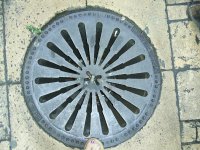
Sarlat, the capital of Périgord Noir, lies in a hollow between hills 10km or so back from the Dordogne river. You hardly notice the modern town, as it's the mainly fifteenth- and sixteenth-century houses of the vieille ville in mellow, honey-coloured stone that draw the attention.
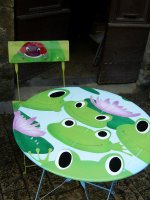
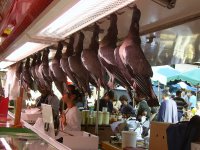
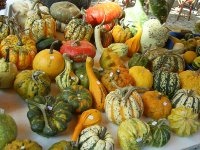
The vieille ville, now thankfully pedestrianized, is an excellent example of medieval organic urban growth, violated only by the straight swath of the rue de la République which cuts through its middle. The west side alone remains relatively un-chic; the east side is where most people wander. As you approach the old town from the station, turn right down rue Lakanal which leads to the large and unexciting Cathédrale St-Sacerdos, mostly dating from its seventeenth-century renovation. Opposite stands the town's finest house, the Maison de La Boétie once the home of Montaigne's friend Étienne de La Boétie, with its gabled tiers of windows and characteristic steep roof stacked with heavy limestone tiles (lauzes).
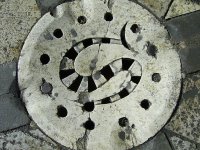
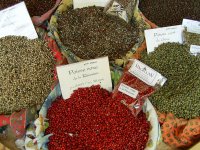
For a better sense of the medieval town, wander through the cool, shady lanes and courtyards – cour des Fontaines and cour des Chanoines – around the back of the cathedral. Directly behind the cathedral is the curious twelfth-century coned tower, the Lanterne des Morts, whose exact function has escaped historians, though the most popular theory is that it was built to commemorate St Bernard, who performed various miracles when he visited the town in 1147.
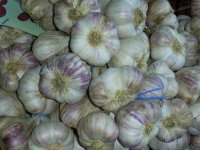
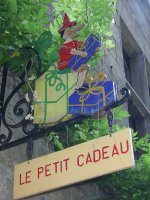
There are more wonderful old houses in the streets to the north, especially rue des Consuls, and up the slopes to the east. Eventually, though, Sarlat's labyrinthine lanes will lead you back to the central place de la Liberté, where the big Saturday market spreads its stands of geese, flowers, foie gras, truffles, walnuts and mushrooms in season, and where various people try to make a living from the hordes who hit Sarlat in the summer.
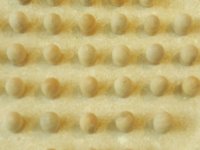
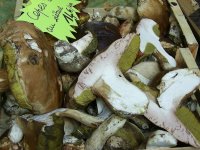

Sarlat, the capital of Périgord Noir, lies in a hollow between hills 10km or so back from the Dordogne river. You hardly notice the modern town, as it's the mainly fifteenth- and sixteenth-century houses of the vieille ville in mellow, honey-coloured stone that draw the attention.



The vieille ville, now thankfully pedestrianized, is an excellent example of medieval organic urban growth, violated only by the straight swath of the rue de la République which cuts through its middle. The west side alone remains relatively un-chic; the east side is where most people wander. As you approach the old town from the station, turn right down rue Lakanal which leads to the large and unexciting Cathédrale St-Sacerdos, mostly dating from its seventeenth-century renovation. Opposite stands the town's finest house, the Maison de La Boétie once the home of Montaigne's friend Étienne de La Boétie, with its gabled tiers of windows and characteristic steep roof stacked with heavy limestone tiles (lauzes).


For a better sense of the medieval town, wander through the cool, shady lanes and courtyards – cour des Fontaines and cour des Chanoines – around the back of the cathedral. Directly behind the cathedral is the curious twelfth-century coned tower, the Lanterne des Morts, whose exact function has escaped historians, though the most popular theory is that it was built to commemorate St Bernard, who performed various miracles when he visited the town in 1147.


There are more wonderful old houses in the streets to the north, especially rue des Consuls, and up the slopes to the east. Eventually, though, Sarlat's labyrinthine lanes will lead you back to the central place de la Liberté, where the big Saturday market spreads its stands of geese, flowers, foie gras, truffles, walnuts and mushrooms in season, and where various people try to make a living from the hordes who hit Sarlat in the summer.


Posted by
Unknown
Friday, October 28
Thursday, October 27
Thursday in Lalinde
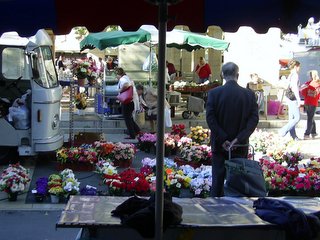 Market day................
Market day................ 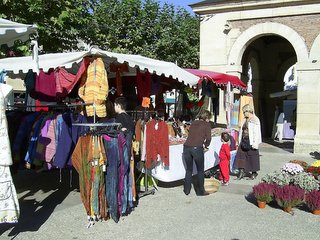 Everything under the sun.......
Everything under the sun.......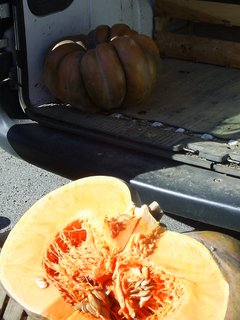 Pumpkins big enough to turn into a Cinderella's coach.........
Pumpkins big enough to turn into a Cinderella's coach.........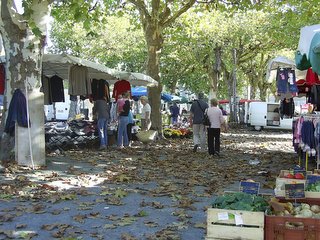 ...................
...................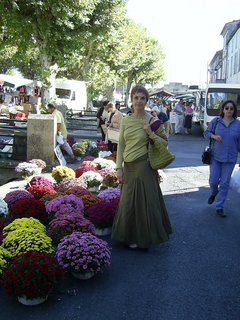 ........
........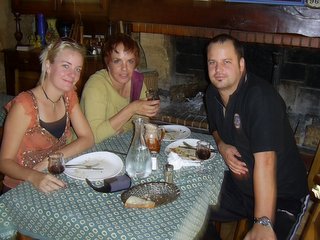 End the morning with a delicious Perigordien lunch and local wine at Le Petit Loup .....
End the morning with a delicious Perigordien lunch and local wine at Le Petit Loup .....
Posted by
Unknown
In the footsteps of the brave........
Since pre-history, 50 000 years ago, cro-magnon man lived in this area, as the many caves carved in the white limestone cliffs along the river attest.
Earliest records of names show that Lalinde started off as Castrum de la lynde in 1270, then La Lindia in 1289, la Linda in 1351, and even Villa Lindeye in 1316 ( villa meaning a town protected by a wall and gate).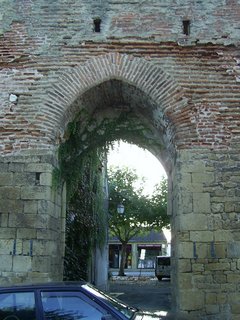
Linda is the occitan (the original local language of the Aquitaine - still taught and still spoken) for source , the spring which still runs as clear and pure as it did hundreds of thousands of years ago.
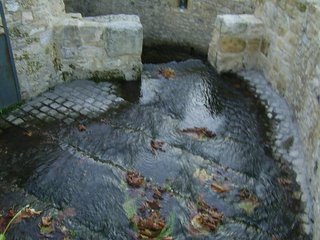
In 1267, Prince Edouard, oldest son of Henry III Plantagenet and Governor of Guyenne, founded the Bastide as we know it today. The bastide was built by a Frenchman, Jean de Grailly, the senechal of Guenne, who was the direct representative of the king of England.
During its long history -- and because of its strategic positioning on the river -- the only place in the Dordogne where the river is ever low enough to forge it, -- and especially during the 100 - year war, Lalinde withstood many sieges, the plague, a complete flooding, a destructive fire. And it was during the WWII that the citizens of Lalinde once more demonstrated their courage and their invincible belief in the freedom of the individual, to the cost of each one of the inhabitants -- when all the young were massacred on 14 June 1944 for the town's important role in the Resistance. Lalinde also became one of the towns in the area which was randomly bombed and burned as revenge against the iron willed people who fought in the Resistance in this region.
Earliest records of names show that Lalinde started off as Castrum de la lynde in 1270, then La Lindia in 1289, la Linda in 1351, and even Villa Lindeye in 1316 ( villa meaning a town protected by a wall and gate).

Linda is the occitan (the original local language of the Aquitaine - still taught and still spoken) for source , the spring which still runs as clear and pure as it did hundreds of thousands of years ago.

In 1267, Prince Edouard, oldest son of Henry III Plantagenet and Governor of Guyenne, founded the Bastide as we know it today. The bastide was built by a Frenchman, Jean de Grailly, the senechal of Guenne, who was the direct representative of the king of England.
During its long history -- and because of its strategic positioning on the river -- the only place in the Dordogne where the river is ever low enough to forge it, -- and especially during the 100 - year war, Lalinde withstood many sieges, the plague, a complete flooding, a destructive fire. And it was during the WWII that the citizens of Lalinde once more demonstrated their courage and their invincible belief in the freedom of the individual, to the cost of each one of the inhabitants -- when all the young were massacred on 14 June 1944 for the town's important role in the Resistance. Lalinde also became one of the towns in the area which was randomly bombed and burned as revenge against the iron willed people who fought in the Resistance in this region.
Posted by
Unknown
Lalinde
 Before being founded as the first English bastide in the Perigord, Lalinde was, from as far back as the Gallo-Roman period, an important fishing village and port for the gabarres , or flat-bottomed wooden boats -- which are still very much part of the daily activity on the Dordogne river, as well as a resting place for the thousands of pilgrims that travelled through this area -- the cross on the square, dating from 1351, stands as reminder of the time of Pope Clement VI, who attracted more than one million pilgrims to Rome.
Before being founded as the first English bastide in the Perigord, Lalinde was, from as far back as the Gallo-Roman period, an important fishing village and port for the gabarres , or flat-bottomed wooden boats -- which are still very much part of the daily activity on the Dordogne river, as well as a resting place for the thousands of pilgrims that travelled through this area -- the cross on the square, dating from 1351, stands as reminder of the time of Pope Clement VI, who attracted more than one million pilgrims to Rome.
Posted by
Unknown
Wednesday, October 26
La Vie est Belle!
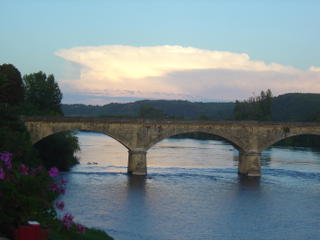
Jacques Brel sang for me this morning in a voice that echoed Gitanes and Pastis and dark dungeon cafes, young girls with heroin stained armpits and dull eyes, of glistening wet pavements, low grey skies, the smell of moules frites and angry charcoal seas and dark nights pierced by cathedral spires……….
Ne me quitte pas, he sang. Ne me quitte pas…….his voice floated down the staircase, deep and resonant and longing
Sipping a bowl of steaming creamy coffee, standing on my terrace, watching the sunrise over the Dordogne.....
Non, moi, je ne quitterai pas.....
Posted by
Unknown
